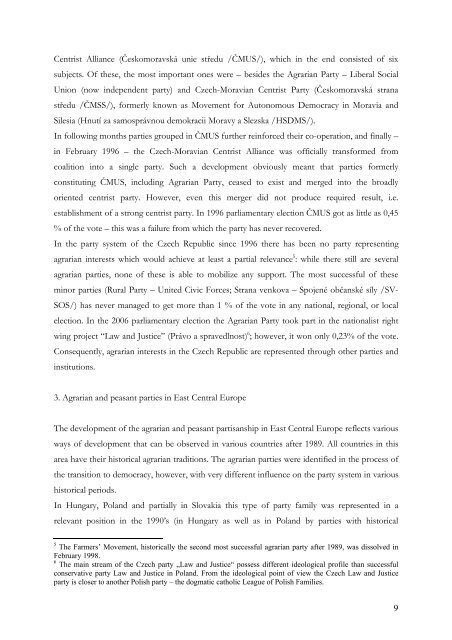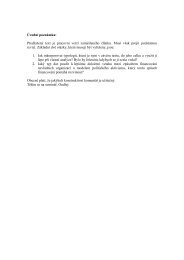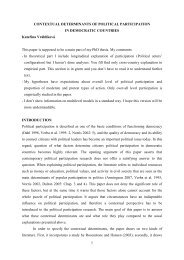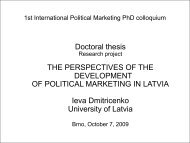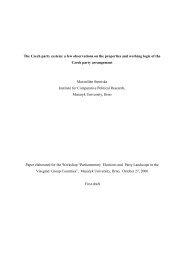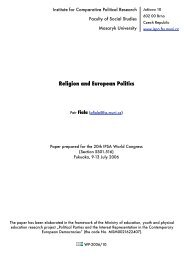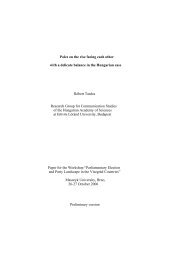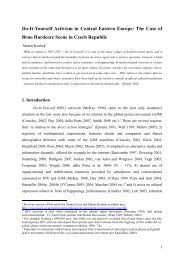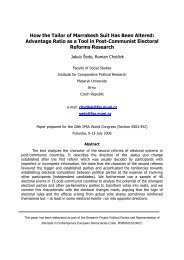Agrarian and Peasant Parties in the Czech Republic - Masarykova ...
Agrarian and Peasant Parties in the Czech Republic - Masarykova ...
Agrarian and Peasant Parties in the Czech Republic - Masarykova ...
Create successful ePaper yourself
Turn your PDF publications into a flip-book with our unique Google optimized e-Paper software.
Centrist Alliance (#eskomoravská unie st"edu /#MUS/), which <strong>in</strong> <strong>the</strong> end consisted of six<br />
subjects. Of <strong>the</strong>se, <strong>the</strong> most important ones were – besides <strong>the</strong> <strong>Agrarian</strong> Party – Liberal Social<br />
Union (now <strong>in</strong>dependent party) <strong>and</strong> <strong>Czech</strong>-Moravian Centrist Party (#eskomoravská strana<br />
st"edu /#MSS/), formerly known as Movement for Autonomous Democracy <strong>in</strong> Moravia <strong>and</strong><br />
Silesia (Hnutí za samosprávnou demokracii Moravy a Slezska /HSDMS/).<br />
In follow<strong>in</strong>g months parties grouped <strong>in</strong> #MUS fur<strong>the</strong>r re<strong>in</strong>forced <strong>the</strong>ir co-operation, <strong>and</strong> f<strong>in</strong>ally –<br />
<strong>in</strong> February 1996 – <strong>the</strong> <strong>Czech</strong>-Moravian Centrist Alliance was officially transformed from<br />
coalition <strong>in</strong>to a s<strong>in</strong>gle party. Such a development obviously meant that parties formerly<br />
constitut<strong>in</strong>g #MUS, <strong>in</strong>clud<strong>in</strong>g <strong>Agrarian</strong> Party, ceased to exist <strong>and</strong> merged <strong>in</strong>to <strong>the</strong> broadly<br />
oriented centrist party. However, even this merger did not produce required result, i.e.<br />
establishment of a strong centrist party. In 1996 parliamentary election #MUS got as little as 0,45<br />
% of <strong>the</strong> vote – this was a failure from which <strong>the</strong> party has never recovered.<br />
In <strong>the</strong> party system of <strong>the</strong> <strong>Czech</strong> <strong>Republic</strong> s<strong>in</strong>ce 1996 <strong>the</strong>re has been no party represent<strong>in</strong>g<br />
agrarian <strong>in</strong>terests which would achieve at least a partial relevance 5 : while <strong>the</strong>re still are several<br />
agrarian parties, none of <strong>the</strong>se is able to mobilize any support. The most successful of <strong>the</strong>se<br />
m<strong>in</strong>or parties (Rural Party – United Civic Forces; Strana venkova – Spojené ob!anské síly /SV-<br />
SOS/) has never managed to get more than 1 % of <strong>the</strong> vote <strong>in</strong> any national, regional, or local<br />
election. In <strong>the</strong> 2006 parliamentary election <strong>the</strong> <strong>Agrarian</strong> Party took part <strong>in</strong> <strong>the</strong> nationalist right<br />
w<strong>in</strong>g project “Law <strong>and</strong> Justice” (Právo a spravedlnost) 6 ; however, it won only 0,23% of <strong>the</strong> vote.<br />
Consequently, agrarian <strong>in</strong>terests <strong>in</strong> <strong>the</strong> <strong>Czech</strong> <strong>Republic</strong> are represented through o<strong>the</strong>r parties <strong>and</strong><br />
<strong>in</strong>stitutions.<br />
3. <strong>Agrarian</strong> <strong>and</strong> peasant parties <strong>in</strong> East Central Europe<br />
The development of <strong>the</strong> agrarian <strong>and</strong> peasant partisanship <strong>in</strong> East Central Europe reflects various<br />
ways of development that can be observed <strong>in</strong> various countries after 1989. All countries <strong>in</strong> this<br />
area have <strong>the</strong>ir historical agrarian traditions. The agrarian parties were identified <strong>in</strong> <strong>the</strong> process of<br />
<strong>the</strong> transition to democracy, however, with very different <strong>in</strong>fluence on <strong>the</strong> party system <strong>in</strong> various<br />
historical periods.<br />
In Hungary, Pol<strong>and</strong> <strong>and</strong> partially <strong>in</strong> Slovakia this type of party family was represented <strong>in</strong> a<br />
relevant position <strong>in</strong> <strong>the</strong> 1990’s (<strong>in</strong> Hungary as well as <strong>in</strong> Pol<strong>and</strong> by parties with historical<br />
5 The Farmers’ Movement, historically <strong>the</strong> second most successful agrarian party after 1989, was dissolved <strong>in</strong><br />
February 1998.<br />
6 The ma<strong>in</strong> stream of <strong>the</strong> <strong>Czech</strong> party „Law <strong>and</strong> Justice“ possess different ideological profile than successful<br />
conservative party Law <strong>and</strong> Justice <strong>in</strong> Pol<strong>and</strong>. From <strong>the</strong> ideological po<strong>in</strong>t of view <strong>the</strong> <strong>Czech</strong> Law <strong>and</strong> Justice<br />
party is closer to ano<strong>the</strong>r Polish party – <strong>the</strong> dogmatic catholic League of Polish Families.<br />
9


